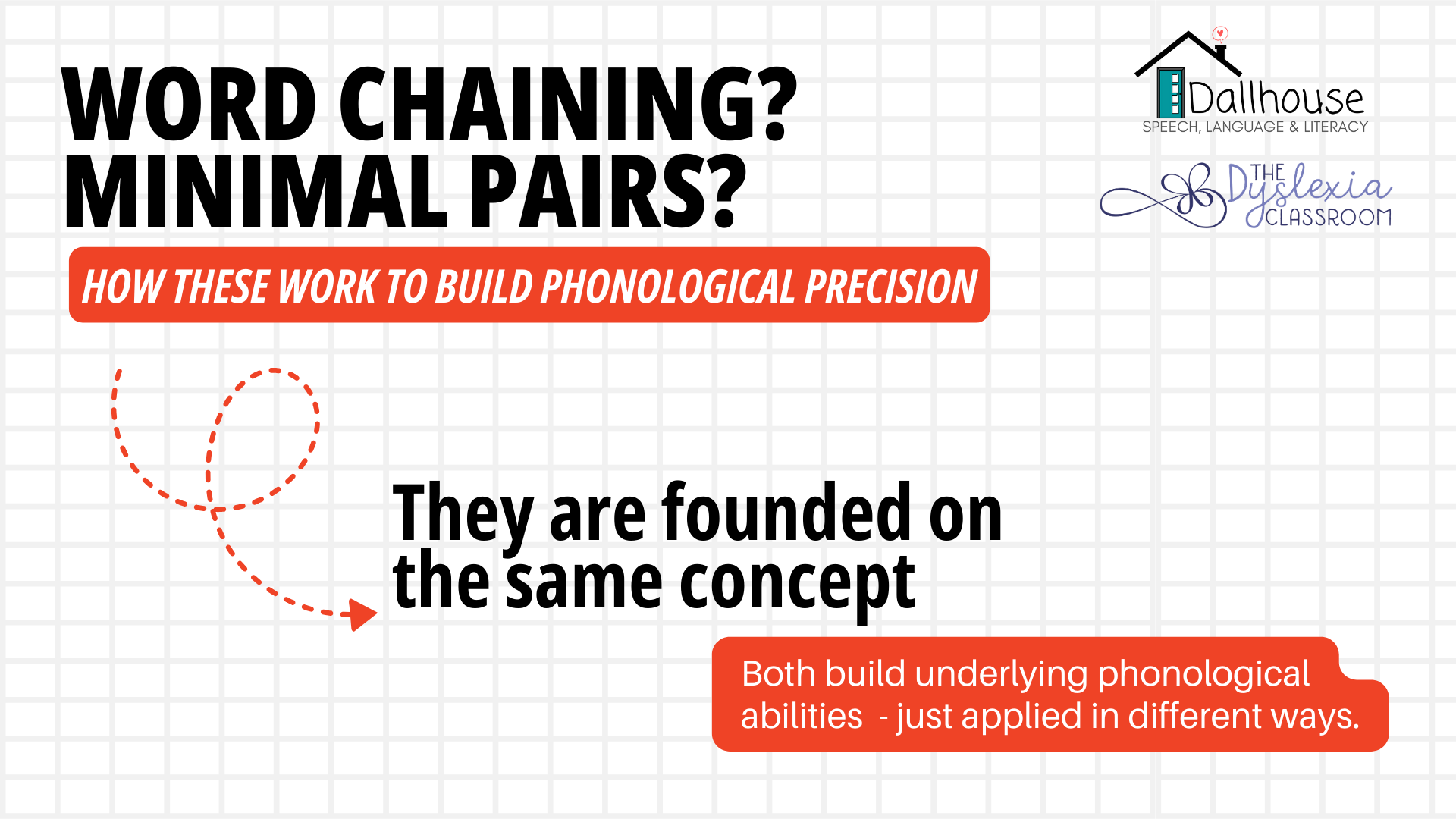From Minimal Pairs to Word Chains: The Speech-Literacy Connection We Can't Ignore
Co-Written by Leanne Dall, MHSc., CCC-SLP, and Casey Harrison, LDT, CSLDS, CALT
*free video link below*
Word chaining has been around for decades, but there's a renewed spotlight on why it's so powerful, especially in the early stages of reading and spelling development. A word chain is essentially a sequence of minimal pairs that we use to improve reading and spelling by focusing on how sounds (phonemes) and letters (graphemes) work together to form words. As we've been reflecting on its impact in light of our newly released CVC Links & Ladders Word Chaining Deck, one truth keeps resurfacing:
Word chaining and minimal pair work share the same phonological roots.

And when we recognize this, our instruction becomes more efficient, more aligned, and more effective.
The Speech–Literacy Link: Why Contrastive Pairs Matter
In speech therapy, SLPs may rely on contrastive phonological approaches, such as minimal and maximal pairs, to spark phonological learning. The minimal pair appro...
Can I Have Your Attention, Please? Why Focus Matters in Dyslexia Lessons

Time is a precious commodity, especially in schools and intervention settings. For students receiving interventions, every moment is crucial, and as educators, we feel a great sense of urgency to utilize every second to provide instruction and close the learning gap. This urgency underscores the importance of our role.
We need to be intentional with our instruction, as students struggling to learn to read and write with proficiency don't have time to waste. However, often in response to this sense of urgency, we dive right into the content, determined to make the most of our time without first setting the stage for learning. Yet, for students with dyslexia, especially those who may also experience attention challenges, skipping over this crucial first step can quietly undermine everything that follows, a decision that carries significant weight.
That step? Gaining and sustaining attention.
If we want our students to master skills, build long-term memory, and truly progress, we must ...
Word Chaining with Meaning

As a dyslexia therapist, I know firsthand the power of connecting sounds, letters, and meaning in ways that truly “stick” for our students. Early literacy should include building flexible pathways that help children unlock reading and spelling with confidence. That’s why I’m so excited to team up with SLP Leanne Dall for this guest post on the Bjorem Speech® blog.
Together, we’re sharing how word chaining with meaning—brought to life through Bjorem’s Links and Ladders CVC Word Chains—can make a big difference in early literacy instruction. By changing just one sound at a time, students don’t just practice phonemic awareness and orthographic mapping; they also strengthen memory, pattern recognition, and comprehension. And because each word is paired with illustrations, the activity lightens cognitive load while reinforcing meaning—a game-changer for students, especially those with dyslexia.
This post is all about blending the science of reading with playful, practical tools you can us...
Don’t Let Struggling Readers Sink: How the Right Kind of Tutoring Helps Them Thrive

I’m thrilled to share a guest post I wrote for EdView360, titled ‘Don’t Let Struggling Readers Sink: How the Right Kind of Tutoring Helps Them Thrive.’ In it, I explore how struggling readers—especially those with dyslexia—need more than hope to catch up; they need Structured Literacy, a research-backed, systematic approach to reading and writing instruction. I explain why this method works and what it entails and offer practical tips for effective tutoring that can transform struggling readers into confident navigators. Check out the full post here —I’d love to hear your feedback or insights!

Aim-Anchor-Release-Reset a strategy for literacy instruction

Today, my twins are competing in the state archery competition, and as a proud mama and forever teacher (☺️) their team saying is one that I feel connects to the current state of reading instruction as well. One of their team sayings is: Draw, Aim, Anchor, Release.
It got me thinking of sayings we can use with our students in reading instruction and what I do in my dyslexia therapy lessons. So this is my little twist on the archery saying: Aim, Anchor, Release, Reset.

A Strategy for Literacy Instruction
This message is great for my children and their archery, but also for my students and myself as I look at our reading instruction and lessons. This got me thinking of how we teach our students, and ways to bring students into this cycle of metacognitive practices to develop their knowledge, awareness, engagement, motivation, and ownership of their learning.
Aim - Focus on our goal or task at hand and aim for those intentions.
How wonderful is this concept for not only our stu...
STOP - or at least pause! Books have a place in dyslexia therapy.

Books have a place in dyslexia therapy. Don’t throw them out, but ask where and when?
Lately I have seen the wave of advice from people to throw out their traditional books and it causes me great pause. I have always been one to pull books out of the giveaway piles and dumpsters - although I will agree that some do in fact need to be let go, I don’t want educators to over-correct in the name of “science”.
There certainly is a place, and necessity, for traditional or authentic books within reading instruction. It is imperative that as educators we understand the purpose of the lessons and materials we use with students. While decodable text lays the critical foundation for our students with dyslexia or those first learning to read, we must understand the role it plays and for how long. We don’t want students remaining in decodable text forever. Decodable text is vital to our instruction - a necessary step on the path to learning to read, but exactly that - a step to move us forward. (...
Understanding When and Why We Use Nonsense Words

After one of my recent podcasts, I received a question about using nonsense words. I love using the Nonsense Word Fluency assessment to gain insight into a student's alphabetic principle and primary phonics. Students need to apply their knowledge of phoneme-grapheme correspondences to decode accurately. However, I caution teachers when using nonsense words within their lessons; why?
This is an important topic to consider as more curriculums implement nonsense words in their lessons, plus many nonsense word lists are for sale that are teacher-made on many platforms, blogs, etc. As we reflect on this practice, we want to consider the purpose of nonsense words, the orthographic patterns used, and the alphabetic principle.
Purpose of Nonsense Words
The original purpose for nonsense words was to be used within an assessment to determine if the student had grasped the alphabetic principle and primary phonics. Research has shown that using nonsense words as an assessment can provide unique...
Quick Tip for Helping Student Comprehension Through Language Structure

Do you ever find your students reading sentences well, and yet they have confusions when you discuss the text? Students need to understand that there are two ways in which to think about a text when reading.
First, they need to understand the words as written on the page and literally be able to read them. This is often referred to as the surface code. When speaking with my students, I refer to this as the “reading voice”. At the basic form, this is the ability to read the words on the page. In addition, there is a second part to reading, in which the reader must pull out the meaning of the text, infer the lesson or message that the author wants the reader to take away.
This deeper level of connecting with the text can certainly become a hurdle if there is a lack of access to vocabulary, background knowledge, language structure, and more. There is a great level of depth we can cover with surface code and text base - but today I want to share a quick tip on helping students with lang...
What Does Spelling Tell Us?

A student came to my center with her spelling test in hand. While the errors were marked on the page by her classroom teacher, if we look beyond the idea of a spelling test, we can see what her spelling indicates as far as her learning and instructional needs. Why?
We can think of reading and spelling as being different sides of the same coin. Reading, or decoding, is applying the sound-symbol relationships and successfully blending them to read a word. Spelling, or encoding, is the ability to segment words by individual sounds and use the correct sound-symbol correspondences in written form. When students write, their spelling gives us great insight into their understanding of sound production and how they represent those in written form. Read more about the connection between reading and spelling in this past blog post.
This young student showed consistent miscues in the use of digraphs ch and sh. Upon first glance, one may think that she simply didn’t know the difference between t...
The Role of Morphology in Syllable Division and Multisyllabic Word Reading

This is part 4 of the syllable types blog series. Read part 1 , part 2 , and part 3 and 3* bonus.
Morphology is a crucial part of structured literacy lessons that teachers should introduce early within reading instruction. In fact, I teach morphemes to my kindergarten students. Why? From the beginning, we want students to understand that words carry meaning, and morphology is a great way to help students deepen their understanding of language. We don't have to wait for this instruction to take place. Instead, we can embed morphology instruction into our lessons and help students with this right from the start.
Morphology instruction, the study of words and how they are formed and used, is one of the elements of structured literacy. When we look at language through the lens of units of meaning within words, that is part of morphology. Dr. Louisa Moats notes, "Knowing morphemes enhances reading, vocabulary, and spelling." (Moats, 2000). As students increase their understanding and use...



